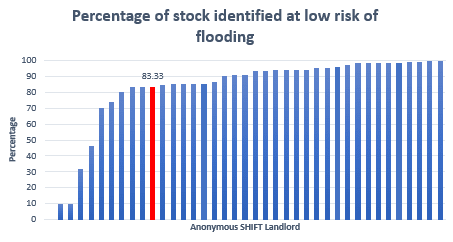
For a recent project we had to include some lists of environmental issues facing the UK. It’s a bit of a random collection, but there are some interesting nuggets in there.
Extra rainfall
Depending on which forecasting model you use and what may or may not happen to humanity’s level of carbon emissions, the level of extra winter rainfall compared to 1981-2010 averages can vary. Average winter rainfall compared to 1981-2010 averages:
- In the case we dramatically reduce carbon emissions, all of the UK can expect to see around 10% extra winter rain
- In the case where emissions continue at the current rate some parts of Scotland could get 30% extra rain
- In the case where emissions carry on growing at the current rate even some parts of South East England will get 10% extra rainfall
The BBC has provided a “look up” where you can see what climate change may mean for your postcode [1].
Rise in sea levels
Another projection due to climate change is higher sea levels, although the Met Office has assessed no extra threat from increased tidal surges in the UK (which are an atmospheric effect and not climactic). These can lead to coastal erosion as well as coastal flooding [2].
The UN Office for Disaster Risk Reduction has designed an interesting educational game to raise awareness about the risk of natural disasters and what to do to reduce their impacts [3].
Increased flood risk
In our consultancy we work with clients to help them discover their flood risk. One group of clients is social housing landlords. If they haven’t done it already, we ask them look at the flood risk of the homes they manage and here is some data from a range of landlords:

You can easily look up the flood risk of where you live using the government’s flood risk checking service and entering your postcode [4].
Food Security
The Global Food Security index is a benchmarking model measuring the drivers of food security across countries [5]. At the time of writing, the UK’s overall score is 81 out of 100 and the scores for the 4 main subcategories are:
- Affordability 91.1
- Availability 72.7
- Quality and safety 89.6
- Natural resources and resilience 69.0
And here’s how we compare to a selection of other countries
- USA – 79.1
- Denmark – 76.5
- Germany – 78.7
- China – 71.3
- India – 57.2
- Kenya – 46.8
Higher temperatures
The central projection is 2°C warmer average summer temperatures, but as with rainfall this can vary widely depending on what happens with future carbon emissions and where in the country you are.
- Assuming a massive reduction in carbon emissions, Scotland will have no change in summer temperature, whereas South East England can expect a 1-2°C increase.
- Assuming a central projection of carbon reductions, average summer temperatures in Scotland could rise by about 1°C and in South East England it could be 2°C.
- In the worst case scenario, where carbon emissions continue unabated, average summer temperatures in Scotland could increase by 1-2°C and the South East of England can expect a 2-3°C increase.
It takes a bit of playing around, but you can examine the relevant maps using the Met Office’s UK Climate Projections [6].
In recent heatwaves in the UK excess deaths are recorded and in 2020 the excess mortality was 2556 deaths over three heatwave periods, which is comparable to the 2003 heatwave. There is on-going research to see if Covid had any amplifying effect on summer deaths [7].
A now-defunct quango-like organisation called Zero Carbon Hub estimated about 20% of homes may already exceed thresholds for overheating, but no-one really knows [8].
Biodiversity
Green spaces and biodiversity have suffered hugely in the UK. Here are some sobering statistics from a recent report [9]:
- The indicator for 696 terrestrial and freshwater species shows a significant decline of 13% in average abundance since 1970 and has fallen by 6% over the past 10 years
- Since 1970, 41% of species have decreased in abundance
- Over the past 10 years, 44% of species have decreased
- Long-term decreases in average abundance in butterflies since 1976 (16%) and moths since 1970 (25%) have not slowed
- The mammal indicator shows little change since 1994
- Declines in common and widespread breeding species
- The total number of breeding birds in the UK fell by 44 million between 1967 and 2009.
Displaced people
Updated statistics from the UNHCR show that weather-related hazards triggered 24.9 million displacements in 2019 and projections could mean over 200 million people per year requiring humanitarian assistance per year by 2050 [10].
If you need hard metrics to design your sustainability strategy, ESG reporting or to check your progress, please be in touch here.
References:
[1] What will climate change look like near me? (bbc.co.uk)
[2] pdfUKCP18 Factsheet: Sea level rise and storm surge. (Metoffice.gov.uk)
[3] https://www.stopdisastersgame.org/stop_disasters/
[4] https://www.gov.uk/check-long-term-flood-risk
[5] https://impact.economist.com/sustainability/project/food-security-index/
[6] https://ukclimateprojections-ui.metoffice.gov.uk/products
[8] Overheating In Homes -The Big Picture (zerocarbonhub.org)
[9] https://nbn.org.uk/wp-content/uploads/2019/09/State-of-Nature-2019-UK-summary.pdf
[10] UNHCR ‘Climate change is the defining crisis of our time and it particularly impacts the displaced’
